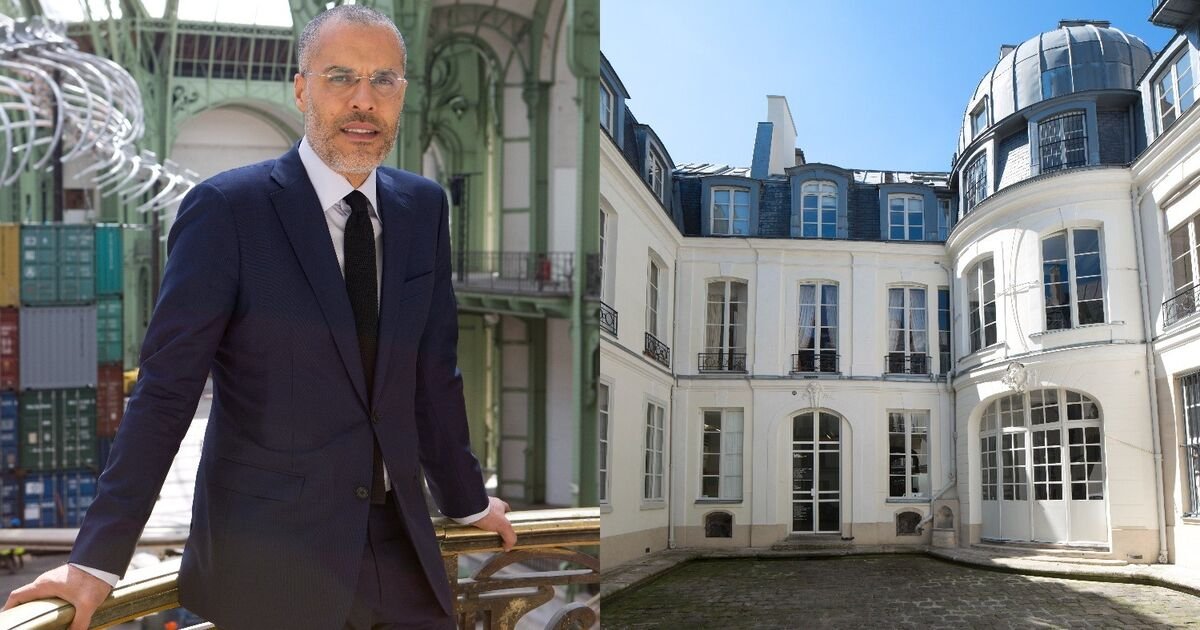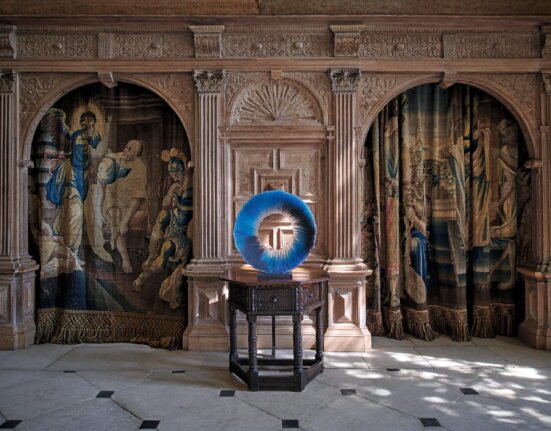Art
Maxwell Rabb
Portrait of Kamel Mennour. Courtesy of Mennour, Paris.
Exterior view of Mennour at 47 rue Saint-André-des-Arts. Courtesy of Mennour, Paris.
As a father of five and the head of four Parisian galleries, Kamel Mennour doesn’t often get time to relax. But even when he does, the energetic gallerist is never entirely at rest. He admits to always keeping a notepad within reach, even placing one outside the shower, ready to jot down any sudden ideas.
His downtime will be particularly precious this week. On October 16th, Paris will once again become the focal point of the international art world with the third edition of Art Basel Paris (formerly known as Paris+ par Art Basel), where Mennour will present the work of 36 artists including On Kawara, Idris Khan, and Pablo Picasso. Meanwhile, his galleries have just launched solo shows spotlighting artists Dhewadi Hadjab and Ugo Rondinone, with another presenting Alicja Kwade. It’s a heartening moment for the Parisian gallery, which has spent the last 25 years evolving with the city’s contemporary art scene. As the eyes of the art world turn to Paris for this week’s events, Mennour is keen to point out that the city wasn’t always the thrumming art hub it is today.
“It was frozen,” Mennour recalled of the city when he set up shop in 1999. “It was an old lady. It was a sleeping lady. It was a museum city—but there was nothing in terms of contemporary art. It was totally dead. When I was traveling, I was saying I was from Paris, and people were laughing, saying, ‘Paris is only for restaurants, hotels, hospitality, or museums. There’s no contemporary art.’ So, for me, it was a challenge because I love my city—I was raised here—so I saw that Paris was the center of the world.”
Now 59, Mennour has become a stronghold of the city he cherishes, and also maintains a steady presence at international art fairs. His gallery has grown to represent about 40 artists, including Anish Kapoor, Tadashi Kawamata, and Lee Ufan. As one of Paris’s most significant galleries reaches this significant anniversary, Mennour isn’t stopping anytime soon, bringing a fresh bullishness towards a city whose art scene looks only to be ascending.
Parisian made
Portrait of Kamel Mennour. Courtesy of Mennour, Paris.
Mennour arrived in Paris from Constantine, Algeria, at the age of two. His mother worked as a cleaning lady, while his father took up jobs as a house painter to make ends meet.
Art came to Mennour indirectly. While earning his master’s in economics at the prestigious Sorbonne University in Paris, he became less interested in his degree and more preoccupied with his part-time job that paid his tuition fees: selling etchings and lithographs. His growing obsession with art was fueled by countless hours of reading and study, and, finally, he decided to make a change.
Exterior view of Mennour at 5 rue du Pont de Lodi. Courtesy of Mennour, Paris.
In 1999, Mennour opened a small 530-square-foot gallery on Rue Mazarine, just south of the Seine—a location far removed from the contemporary art galleries in the Marais and the 13th arrondissement. “In my area, there were no contemporary galleries—all the galleries were in another part of the city. So, my gallery was extremely isolated,” he recalled.
Mennour dedicated the space to presenting photography, with names such as Stephen Shore, Annie Leibovitz, Peter Beard, Daido Moriyama, and Nobuyoshi Araki among those exhibited. By 2003, the gallerist began to broaden his scope to encompass a broader spectrum of contemporary art, inviting young artists like Claude Lévêque and François Morellet to show at the gallery. This renewed mission was validated further when French luminary Daniel Buren selected Mennour as his gallery representative in 2005.
Growing with the Parisian art scene
Despite being home to some of the most prestigious art institutions in the world, the Paris that Mennour came up in was far from a force in the contemporary art world. “Paris was collapsing. Paris was nothing,” said Mennour.
The gallerist’s trajectory in the years since his space first opened is marked by an unwavering belief in the city that he calls home. In addition to showcasing heavyweight names such as Huang Yong Ping, Kapoor, Kawamata, and Ufan, Mennour has expanded to four spaces across the French capital. Perhaps most significantly, he upgraded his initial gallery space to the 17th-century Hôtel Particulier de Vieuville in 2007. This new 4,300-square-meter location provided the proper platform for the more emerging artists on his roster at the time—Mohamed Bourouissa, Dario Escobar, and Kwade—as well as those established names.
Mennour’s initial optimism towards his city is starting to pay off, with Paris finding itself back in the international limelight of the contemporary art world. A new generation of Parisian gallerists and the arrival of Art Basel three years ago have brought renewed energy to the city. “It took a lot of years, but people smelled like there was something here, and then suddenly Paris was reaffirmed,” Mennour said.
But the contemporary art “boom,” as he calls it, is not without its challenges. One that he mentions is the exodus of artists to other cities like Berlin due to Paris’s high living costs. “The blood of a city is artists, and artists are now in Berlin rather than in Paris because Paris is very expensive, so I hope that the government could do some help or assistance,” he said. He described this current period in the Parisian art world as “a moment of stabilization,” where new contemporary-focused institutions, like the Fondation Cartier and Lafayette Anticipations, are helping usher in this new era.
Mennour is also doing his bit to support the Parisian art world beyond his gallery’s walls. In September 2023, he launched the Mennour Institute, dedicated to education, philanthropy, and research into 20th- and 21st-century art history. This space is intended to help foster the next generation of the arts in Paris.
“We are bringing students and giving awards to very young emerging artists, so this is part of the game because we are becoming old now,” he said. “At 25 years, it’s when you can give back a little bit.”
In 2015, he also launched the HEROES for Imagine project, after his firstborn son was cured of a bone tumor at 15 months. The initiative has raised more than €22 million ($24 million) for the Imagine Institute, an organization devoted to genetic illness research.
An artist-first approach
Portrait of Kamel Mennour. Courtesy of Mennour, Paris.
A critical quality of Mennour’s gallery programming is driven by his willingness to pursue ambitious projects alongside his artists. For him, no project is too big—and consistently, the gallery’s exhibitions shatter the limitations of a commercial “white cube” space. At any instance, the gallery space could be covered in a wooden installation by Kawamata, populated by giant cockroaches by Ping, or geometric prisms installed by Buren. All the while, Mennour supports his artists’ projects worldwide, as evident with Claire Fontaine’s text-based installation during the 60th Venice Biennale.
One favorite of the gallerist was Kwade’s installation of stone orbs and Escher-like concrete staircases at the Place Vendôme during the inaugural Paris+ par Art Basel. In Mennour’s eyes, projects like these elevate both the artist’s career and the surrounding environments in which they are placed. “You are in the street, and you see these huge sculptures, you see that the city is waiting, so it’s very good for the art market, for the art scene, for the vibe, for everyone,” he said.
Alicja Kwade, installation view of “Blues Days Dust” Mennour (47 rue Saint-André-des-Arts, Paris 6), 2024. © Alicja Kwade. Photo by Archives Mennour. Courtesy the artist and Mennour, Paris.
Mennour says he’s often driven by his experiences with the artists themselves, most recently announcing the representation of Fontaine and British artists Idris Khan and Ryan Gander ahead of last year’s Paris+ Art Basel. This hands-on approach is likely why the storied gallerist has managed to maintain his roster of A-lister artists, from small beginnings to his status as a Parisian powerhouse.
“My motivation is mostly being with the artists: projects, programming, and having discussions and finding ways or ideas with your artists,” said Mennour. “Getting [together] with a live artist is the most beautiful gift that you can have. I love being with artists—they always bring us to another level, and they elevate you. Artists could be the way to get out from all the pessimism we have now…artists could be the way to see a better world.”
MR

Maxwell Rabb
Maxwell Rabb is Artsy’s Staff Writer.







